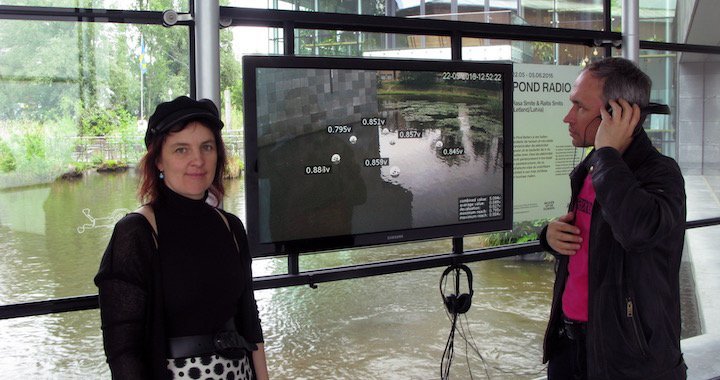
The sensorial feel for data
A conversation with Rasa Šmita and Raitis Šmits, nominees for the 2019 Purvītis Prize
18/02/2019
This is the first time that new media artists and curators Rasa Šmita and Raitis Šmits have been nominated for the Purvītis Prize. It was their 2017 exhibition titled Mikropasauļu svārstības (Fluctuations of Microworlds), featuring the practical and aesthetic aspects of bog bacteria, that attracted the attention of the judging committee. Both artists graduated from the Art Academy of Latvia (AAL) in 1993, and have been recognised as being Latvia’s pioneers in the field of new media culture. They quickly realised that they wish to link their artistic endeavors with the just-emerging opportunities arising from the discipline of information technologies, and, undeterred by the combined forces of a lack of societal support and the financial difficulties of the 90s, founded the E-LAB Electronic Art and Media Centre in 1996. In 2000, the venture transformed into the considerably larger RIXC Centre for New Media Culture, which continues to thrive to this very day. RIXC currently operates as a nerve centre for practically everything having to do with new media art in Latvia: its location at Lenču iela 2 constantly holds exhibitions featuring new and emerging artists; the MPLab Art Research Laboratory, part of the Faculty of Humanities at Liepāja University, was founded under the auspices of RIXC; and international-scale exhibitions and conferences are held every year, including the annual RIXC Art Science Festival, which always features an impressive number of foreign artists and guest lecturers. At the beginning of their joint career, Šmita and Šmits were awarded the Prix Ars Electronica for their internet art project Xchange Net.Radio Network; after that, their works were exhibited at the Ars Electronica center in Austria, the KUMU museum in Tallinn, the Van Abbemuseum in Eindhoven, the Swedish National Museum of Science and Technology in Stockholm, the RAM gallery in Oslo, and elsewhere. Rasa currently also works as an educator at Liepāja University, while Raitis does the same at AAL.
Both Rasa and Raitis continue to keep a finger on the pulse of RIXC and its affiliated events, actively filling the Centre’s leadership and management positions, as well as organising events and curating exhibitions. All of this (including their family life) notwithstanding, they are first and foremost artists who manage to find time for the creation of their own personal projects. The fact that one of these, Fluctuations of Microworlds, has garnered the recognition of the Purvītis Prize judging committee could be also be seen as symbolic acknowledgement that, after more than 20 years of work in the field of new media art, the partnership of Šmita and Šmits deserves to be permanently recorded as having achieved a top spot in the annals Latvian art.
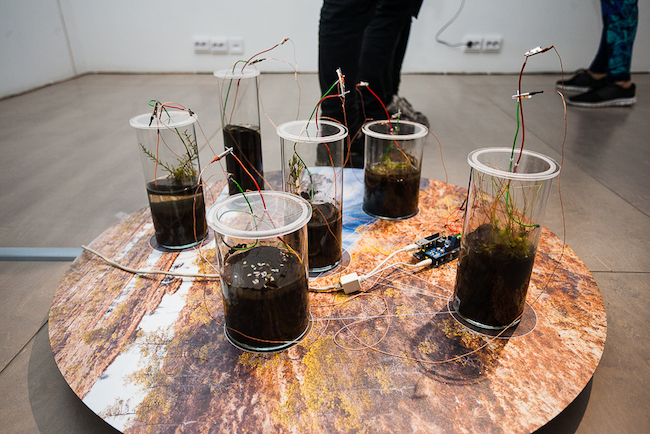
Opening of the exhibition "Fluctuations of Microworlds" on September 9, 2017. © RIXC
From all of the work you’ve done, why do you think this is the one that was shortlisted for the Purvītis Prize?
Rasa: I think that this nomination is saying that we’ve gone quite a ways down this road by now. We are in no way artists just starting out, although the very first [career] upsurge is usually the easiest. As soon as we started out in the 90s, we got the Ars Electronica award...all roads were open to us… There was this overall sense that the world was beautiful, bright and wonderful. And then the difficult years come; you try to get over them and try to find yourself anew at a point when you are no longer the young beginner. To me, that phase seems to be the hardest one. And if you’re acknowledged after having survived that stage, then the nomination takes on a completely different meaning.
Raitis: This work was created over a long period of time. It’s had various stages which have been shown in various ways in several exhibitions, but in this case there were two individual parts. In one, we looked at microbial fuel cells.
Rasa: Bacterial batteries!
Raitis: One part is the ‘gallery’, or indoor, version; the second one, and which interests us the most, works outdoors – in a clean, direct environment. We began with ponds, and in the exhibition we show the installation materials that were created when we worked at the Van Abbemuseum, a museum of contemporary art in Eindhoven. Next to the museum there is a river that has a backwater pond that lies directly adjacent to the museum building, and that’s where we put the installation in its in situ live version. That supplied a portion of the collected data and the video footage, from which we then made the images, prints, and the sculpture. For the second part we used bogs right here in Latvia. It was from these bogs that the second part of the installation was derived – instead of collecting data, we literally collected living bacteria from the mud of the bog, which then powered, in real time, the second part of the installation: the image and sound manipulations and a 360-degree virtual reality video. This was probably the largest presentation of the process which we had been working on since 2012.
Rasa: I think that Fluctuations of Microworlds specifically was a good fit for the Purvītis Prize shortlist because it was with that project that we moved away from a tight focus on technologies, and more into an interdisciplinary field. This exhibition demonstrated the diversity of our interests and activities – we organise festivals and conferences, we think, we read books, we follow current events and the latest ideas in ecological theory, and, of course, what is new in art. In this post-media situation there’s a tendency to create objects – whether it’s ‘fine art’, sculpture, or media art. These seemingly discrete fields are beginning to merge; media usage is increasingly overlapping – it is no longer the case that only digital media artists use digital media. And it is all of this that we tried to interpret in our works – we represented it in making our sculpture. The same applies to the time-lapse video, which is actually extremely interesting! It’s so interesting to watch a period of eight or nine months in ten minutes because, 20-plus years ago, it was precisely the fact that we could follow along with something in real time which fascinated us; now it seems that real time is not all that dynamic – it doesn’t fit in with...well, the times. In the 90s, however, it was interesting.
Raitis: It is terribly boring.
Rasa: Terribly boring! However, it is interesting when, in the middle of the night, you notice that some ducks have settled down on top of your electrodes in the pond, and you don’t know what to do – do you run over to the botanical gardens and shoo them off, or do you go back to bed? Or, when you see how spiders crawl over your setup at night, or, when you wake up in the morning and you can see whether the pond is thawing or not. But it truly is much better to be able to watch it all in ten minutes. We did have a moment there when we, as artist who work with technologies, had to ponder the question of ‘What is the role of technology in art?’ And then comes the issue of the new aesthetic – what is technology’s unique contribution? We began to come to the realisation that the turning point had been reached: technology is no longer sufficient enough on its own – as it is in the avant-garde, when it is still new and can be art all on its own. This period of it being avant-garde is very short. Once it has passed, we begin to view not only all of the artistic and aesthetic values that can still be revealed during the process of data visualisation, but also when we zoom out from it all – when we step back from the bacteria/microbial environment and see what it looks like on a larger scale. We used drones to film bogs, imagining what it would be like if such a large and empty ecological ecosystem could become, perhaps, even an intelligent organism that possesses something that we, as a society, require – for instance, bacteria that generate electricity. And maybe at that moment, it manifested for as a unified artistic vision – a vision that, evidently, other people and the judging committee could also see.

Opening of the exhibition "Fluctuations of Microworlds" on September 9, 2017. © RIXC
You both received a normal, classical art education at AAL. How did it happen that, in the 90s, your interests and activities led straight to new media art? I’m guessing you each have different answers…
Rasa: We probably don’t, right? [Both chuckle] We met while at the Academy, and then we both went on our first student exchange programme to the Netherlands, to one of the first schools with which there was a cooperative agreement.
Raitis: Yes, the first contacts with international academies had just been established.
Which year was that?
Rasa: 1994. It was for one semester.
Raitis: So, we were in the Netherlands, and they had a computer class. In 1994!
Rasa: That was the very first course that we selected.
Raitis: It’s how I learned what computers really are. The internet was also a completely new thing. That was probably the first instance of our interest in that. The second instance happened when we went to Tallinn, where…
Rasa: The Soros Art Centre there was organising a conference titled Understanding Interactivity, and we immediately knew that we just had to be there, no matter what may get in our way. That was something that we were interested in.
Raitis: It was the first place where we met a lot of people who had also just come upon this interest. Back then, it mostly concerned art on the internet since the internet was an entirely new media. Computer art had already been established, and we didn't have any programing skills – we only knew a little bit about working with programs at the interface level, and we also hadn't really seen anything, but then the internet suddenly appeared. The communicative aspect of it also probably played its part – we were all extremely hungry over here, having been sitting behind the Iron Curtain all this while. And suddenly everything becomes so accessible – all you need is a computer and a modem. At first, there was this huge jolt from the fact that you can now communicate through the internet and find people and artists in other places that are interested in the same things as you. Basically, it’s what Manuel Castells (Spanish sociologist – ed.) says: you have a tool with which you can simply make a bubble in which people with the same interests live and exist, no matter where in the world they may live geographically.
Rasa: As the telecommunications art pioneer Robert Adrian once said, there are artists who, more than anything, want to communicate. And these are the artists who later become the internet artists for whom it is very important that they are able to communicate. But I remember that feeling: you’ve graduated from the Academy, you kind of want to become an artist, you’ve learned a lot and feel a bit antsy and ready to go, but then you come up against the issue of how does one become an avant-garde artist? I remember how I felt when I would think to myself – but how did van Gogh become [an artist]? And Leonardo – did he have the same feeling…? How can one just start a new course? I remember having this idea in the background all the time, and I realised that it was the only one that interested me.

Opening of the exhibition "Fluctuations of Microworlds" on September 9, 2017. © RIXC
To be an avant-garde artist?
Rasa: Yes. But you don’t understand how to go about doing it. And that's why we travelled all over – we went to America, visited all the museums...then there was Holland... We began looking for all kinds of opportunities very quickly: we had five solo shows in two years. When you graduate from the art academy, you don't understand how things work right away – how art even ‘happens’, for that matter. That’s why this act of recognition, or of being nominated, is very appropriate. If you’re not being critiqued, if you’re not getting reviews – regardless if positive, negative, or anything – you may not even understand what it is that you are doing. You feel as if you’re working in a vacuum; and that was one of the most unpleasant of feelings.
Raitis: Yes, that is the hardest one because there’s no reference point. If there’s critique, that’s good; if there’s praise, that’s even better; but indifference… I think a long time ago, some artist likened it to feeling as if you’re working within a wad of cotton wool.
Rasa: It’s understandable because, for a long time, our context was too removed from the expectations of others. It is, after all, a very specific community. Worldwide, we’re around 10,000 people, no more. It is clearly smaller than any general contemporary art community. Everything in Latvia is even smaller – we’re maybe ten people. But it’s not exactly all-the-rage elsewhere, either. There are countries like Germany – perhaps Austria, perhaps the Netherlands – which are specific and where there is more of a tradition in terms of technological art… But these are the exceptions, not the rule.
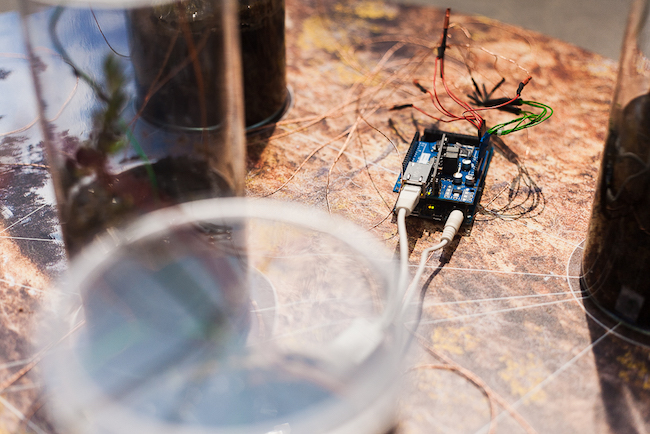
Opening of the exhibition "Fluctuations of Microworlds" on September 9, 2017. © RIXC
Will there come a time when new media art will cause classic art – meaning art that is intrinsically material and has one original exemplar – irrelevant?
Raitis: I think that there will always remain something of classic art. There is nothing easier than putting a picture up on the wall, that is, in the sense of ownership, preservation and enjoyment – you just have to look at it. That’s why the variety of art that is related to the graphic arts, painting and photography will always persist. There’s also new media art that manifests itself through various kinds of digital images. There’s a huge variety of processes, real-time installations and so on, and then suddenly, you capture one section or slice of it – and you get a picture out of it. There are artists who quite consciously work in that direction.
Rasa: Yes; I think the role of new media art is that which is most apt to change – it can go towards the locus of practical solutions as well as combine itself with sculpturesque art because sculpturesque art is now also highly influenced by technology. Photoshop is handy for every artist, as is a camera. In our experience, I’d say that art is once again being dominated by sculpturesque art. There really are no avant-garde forms at the moment; it’s more a period of ‘object-hood’, that is, art that can be displayed in a gallery or taken to Venice or elsewhere. We had an interesting collaboration with the Lithuanian pavilion at the Venice Architecture Biennale. The Lithuanians had made a ‘bog pavilion’ in which our installation was, in fact, the central point around which they organised many of their events. It was very interesting how they continued to conceptualise the bog through various cultural theories, as well as through architecture and also through the bog itself. It was a fascinating experience for us as well. And in a context like Venice, our work looked rather avant-garde, frankly. The installation unequivocally implied that new media art is still a very new field.
Does this walking away from ‘object-hood’ ever confuse or frighten you? After all, we are extremely used to thinking of a work of art as a thing that is fixed in time and space, whereas, for example, virtual reality artworks really do not exist anywhere in the surrounding environment.
Raitis: When we started working together and founded E-LAB, our main focus was on the process. We have always declared that the most important thing for us is the process, and it was. But when working within any art system, some part of yourself demands that you have both a result and a materialisation of that result.
Rasa: So that you have some point of reference.
Raitis: It's also cool to work with completely analog materials. What is cumbersome is that, as a result, huge amounts of material things are produced.
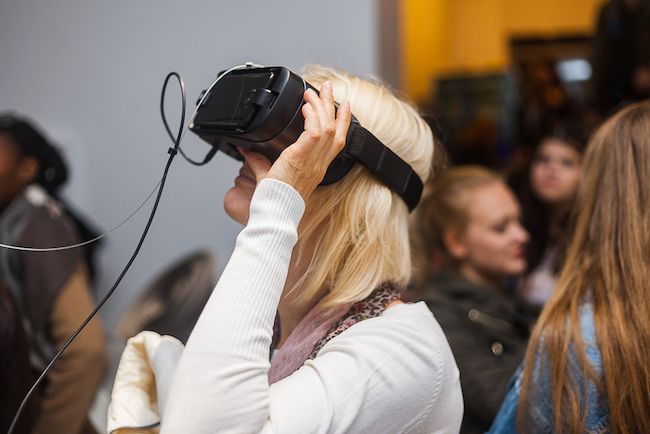
Opening of the exhibition "Fluctuations of Microworlds" on September 9, 2017. © RIXC
You mean ‘stuff’.
Raitis: Exactly – you make large amounts of all sorts of ‘stuff’. That is our Western tradition – we inherit knowledge while also preserving much of what came previously. The issue of preserving is also problematic in media art, and even in video art. It becomes even more complicated in digital media since, as we know, technologies change and the older ones become obsolete. The VR headsets currently in use will, most likely, be incompatible with something in ten years. The thousands of problems that need to be addressed by engineers make it difficult. It is, in some sense, due to our Western traditions that we keep things. We learn from what has been saved so far, and then educate the next generation with it. That is how we hand down knowledge. At least part of our knowledge. And this creates cumbersome side effects. I just read an article on MoMA and about the huge amounts of artworks that they have in storage, of which many have been exhibited once – or perhaps not at all. They have huge storage facilities, and the works collecting dust in them have been seen by only a very small group of people. And that’s just the museum’s collection, which doesn’t even take into account what the artists themselves have personally stored away. Which is why there was this, in some sense, idealism in terms of a virtual format in which everything is essentially intangible.
‘There was’, you say.
Raitis: Well, when we started working, there was, yes.
Rasa: Yes; a museum without walls. But even recently, when we focused on these invisible bacteria, it seemed to us that it was interesting in the same way that it used to be with electromagnetic waves or virtual space – the perception of immateriality has always supplied us with questions and has led us to some ideas. Because another thing that we can do today with digital methods is make the invisible world visible.
Raitis: When it comes to biology, I think there is potential for a real eruption, including in terms of art. Because that is what we are composed of, and there is still a lot that we don't know about it; the body and biological processes are so interesting and so expansive that it’s no wonder that many artists are now trying to work with genetics. There is great potential there.
Rasa: We cannot simplistically say that there are only purely organic processes going on there. The most interesting thing that these technologies have elicited in us is that we are now trying to connect with these other living forms of nature – both visible and invisible ones – a little bit differently. To sense it a little differently; or to see it differently.
Raitis: Our friend, the musician David Rothenberg, works and plays music together with nature – with birds, cicadas, trees and the wind; his theory is that processes in nature do not just happen as it is assumed in the rationalist or technocratic world, i.e. that it's just reproduction and survival. He believes that beauty exists for the sake of beauty. For example, the peacock’s tail – Ok, we can probably rationalise that it has to do with evolutionary selection for mating or whatever else – but the tail can also be beautiful simply for beauty’s sake. Or, for example, whale song, with which whales call out to one another. It can be beautiful purely for beauty’s sake. And that's something that you can neither prove nor disprove. But in art, it is extremely good material for contemplation.
Rasa: And that's what we did with the bacteria. We moved away from the fact that they produce electricity, and instead, put the emphasis on how wonderfully they fluctuate – that they are the living creatures that, in addition to producing the electricity that we so desperately need, also create wonderful visual structures in nature. They live in the ecosystem that lies at the bottom of bodies of water or in bogs, ecosystems that have been forming there for thousands of years and with many layers... At the same time, the bog is also a modern-day paradise – actually, an oasis – in which nothing really happens. Perhaps, in very, very ancient times, it looked just like it does now. And maybe it will continue to look like that for a long time hence. We walked barefoot in the bog, and we performed and filmed our latest works there... You have to understand that the whole thing was moving. It’s a unique feeling – you no longer really know where you are. This sensory, bodily contact with living nature has once again become a new experience that we might also want to show in our art – through the real-time installation and all of the other interpretations. So that one can sensorially feel what the data look like.
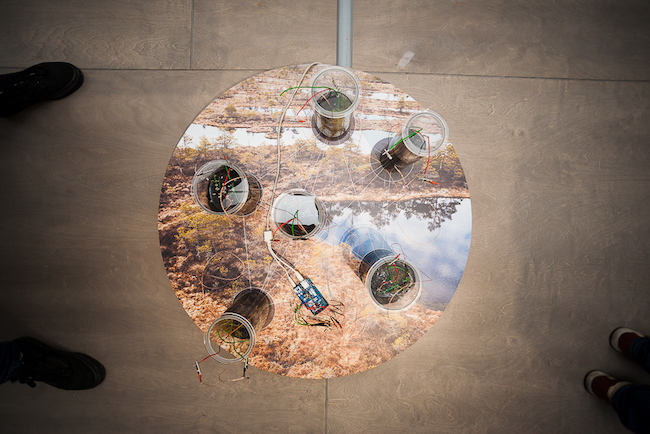
Opening of the exhibition "Fluctuations of Microworlds" on September 9, 2017. © RIXC